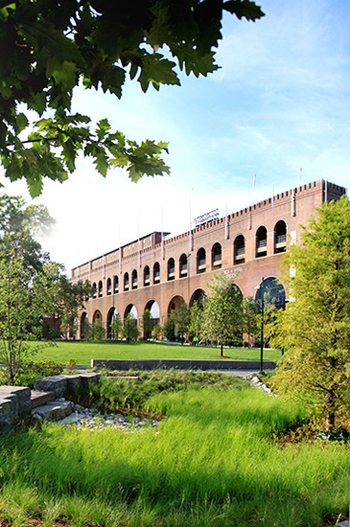"We are designing ever more complex systems, and it's complicated to see if they are performing as they should. You can't just look at a rain garden and say, 'yes, it's working,'" said Eric Kramer, ASLA, a principal with Reed Hilderbrand at the ASLA 2015 Annual Meeting in Chicago. "With living systems, you have to check in over time." So how can landscape architects check in with their projects to see if they are actually working? The answer may be to use commissioning, a process in which performance standards are established and then measured and verified over time. In the era where landscape architects may be expected to measure every ecosystem service, this approach increasingly makes sense as a way to capture value.
Christian Gabriel, ASLA, design director for landscape architecture, General Services Administration (GSA), said commissioning is different from post-occupancy reviews. Commissioning is about setting performance standards from the beginning of a project and then designing, implementing, and monitoring the project according to those standards. While commissioning agents do cost extra -- typically 0.5 - 1.5 percent of the total project budget -- Gabriel says their help can save 8 - 20 percent in annual operating costs.
Bringing in a commissioning agent as part of the design team early on can help the design and construction team "refine the design intent, validate system performance, document decision-making, and properly train operations staff." Commissioning during the planning process helps to "marry performance with design. We can achieve net zero carbon and water with real intent now." And post-construction, commissioning agents then work with landscape architects to measure and verify that a landscape is actually hitting its performance goals -- "and if not, they show them how to correct issues."
For Gabriel, commissioning early on in the process also means an enhanced role for the landscape architect in the overall site design process. Because landscapes are now expected to actually perform, "landscape become a primary system; site design is no longer overlaid, but intrinsic to performance."
But is all of this extra hassle really worth it? "Why does landscape performance matter?," asked Thomas Amoroso, ASLA, a principal with Andropogon Associates. For him, landscapes in urban areas are increasingly valuable because "they now have responsibility to perform against a multitude of factors." Those multi-million-dollar sustainable parks being created are complicated living systems, with many demands placed on them. "And they are competing for limited space and limited dollars," so landscape architects need to be able to show that they actually perform. "We need to prove that they're doing what we say they're doing."
As for their 3-acre Shoemaker Green project (see image above), found on the University of Pennsylvania campus in Philadelphia, Andropogon is monitoring this sustainable park to see if it performs as it should. Shoemaker Green is not only a park but also a sophisticated stormwater conveyance and capture system. Underground, there are 20,000-gallon cisterns. There are designed plant and soil systems. UPenn and Andropogon together co-wrote a grant to finance field analysis of the project over 5 years, using scientific instruments to measure performance in terms of water, soils, vegetation, and human activity.
Andropogon plans to share the data when they are done analyzing. Amoroso believes the firm and the wider design community will "benefit as much from the bad news as good." But he also questioned whether their DIY approach to performance measurement was sustainable, given it's a significant overhead cost. Hiring a commissioning firm that specializes in this kind of work could have benefits.
And then Kramer, with Reed Hilderbrand, walked us through their complicated landscape project, with tiered reflecting pools at the Clark Art Institute, a museum and research center in Williamstown, Massachusetts. Clark Art Institute brought in Aramark, a commissioning agent who applied their principles to every facet of the project -- observe, test, and repeat -- to help fix an issue with one of the pool purifiers, which kept clogging. Throughout a retro-commissioning process, Aramark helped create a testing strategy for each design intention. But Kramer said Aramark needed a bit of training, too, because it hadn't come across some of the issues involved in measuring landscape performance (and this really may be the case with the majority of commissioning agents, who typically focus on buildings and engineered systems).
Kramer said landscape architects and clients should bring in commissioning agents in the beginning because "they have the broad view." With them there, all of the various subcontractors "opened up." Aramark helped them "create a worldview, a coherent narrative, so we didn't fight about it but just fixed it. That was the real benefit for everyone."
He also directed a point at Gabriel, arguing that "GSA needs to get behind landscape performance and commissioning standards, so the rest of the world can get behind them." He argued that an "industry-wide discussion is needed, with clients and contractors involved in setting standards." Given GSA's renewed focus on landscape architecture, hopefully we'll see some progress soon.


